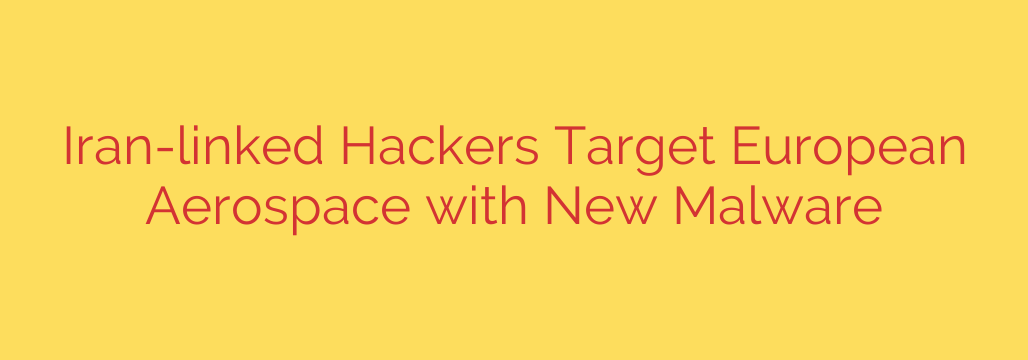
European Aerospace Under Siege: Iran-Linked Hackers Unveil Sophisticated New Malware
A new wave of highly targeted cyberattacks is putting the European aerospace and defense sectors on high alert. Security researchers have identified a sophisticated campaign, attributed to threat actors with links to Iran, that leverages custom-built malware designed for long-term espionage and data theft. This operation underscores the growing threat that nation-state hacking groups pose to critical infrastructure and high-value industries.
The primary goal of this campaign is clear: cyber espionage aimed at stealing sensitive intellectual property. The attackers are systematically targeting companies within the aerospace, defense, and aviation supply chains to gain access to proprietary designs, military technology, and strategic corporate information.
The Anatomy of a Targeted Attack
Unlike widespread phishing or ransomware campaigns, these attacks are meticulously planned and executed with precision. The threat actors demonstrate a deep understanding of their targets, often using carefully crafted social engineering tactics to gain an initial foothold.
The typical attack chain involves:
- Initial Access: Gaining entry through methods like spear-phishing emails containing malicious attachments or by exploiting known vulnerabilities in public-facing software.
- Deployment of Custom Malware: Once inside a network, the hackers deploy a new, previously unseen malware variant. This custom tool is specifically designed to evade traditional antivirus solutions and security scanners.
- Establishing Persistence: The malware creates a persistent backdoor into the compromised system, ensuring the attackers can maintain access over long periods, even if the machine is rebooted.
- Data Exfiltration: The primary function of the malware is to quietly search for, package, and exfiltrate sensitive files to a remote command and control (C2) server controlled by the attackers.
The stealthy nature of this new malware is particularly concerning. It is engineered to operate discreetly, minimizing its digital footprint to avoid detection by security teams. This allows the hackers to remain embedded in a network for months, continuously siphoning valuable data without raising alarms.
Why the Aerospace and Defense Sectors?
Aerospace and defense companies are prime targets for nation-state actors for several strategic reasons. The information held by these organizations is incredibly valuable, both economically and militarily. By stealing this data, a foreign power can:
- Accelerate its own military and technological development by reverse-engineering stolen designs and research.
- Gain a strategic advantage by uncovering the capabilities and weaknesses of another nation’s defense systems.
- Disrupt complex supply chains that are critical to national security.
This campaign is a stark reminder that the battle for technological supremacy is increasingly being fought in the digital realm. The theft of sensitive intellectual property from these sectors poses a direct threat to national and international security.
Actionable Security Recommendations for High-Value Targets
Organizations in the aerospace, defense, and other critical sectors must adopt a proactive and layered security posture to defend against such advanced persistent threats (APTs). Standard security measures are often not enough.
Here are essential steps to bolster your defenses:
Enhance Endpoint Detection and Response (EDR): Deploy advanced EDR solutions that use behavioral analysis to detect malicious activity, rather than relying solely on known malware signatures. This is crucial for identifying novel, custom-built threats.
Implement Robust Email Security: Since spear-phishing is a common entry point, utilize advanced email filtering systems to block malicious attachments and links. Combine this with continuous employee training to help them recognize and report suspicious emails.
Practice Network Segmentation: Divide your network into smaller, isolated segments. This can limit an attacker’s ability to move laterally across your network if one segment is compromised, containing the breach and protecting your most critical assets.
Enforce the Principle of Least Privilege: Ensure that users and accounts only have the minimum level of access necessary to perform their jobs. This reduces the attack surface and minimizes the damage a compromised account can cause.
Develop a Proactive Threat Hunting Program: Don’t wait for an alert. Actively search your networks for signs of compromise and Indicators of Compromise (IOCs) associated with known threat actors.
The emergence of this new malware campaign is a serious development. It highlights the persistent and evolving nature of state-sponsored cyber threats. For organizations operating in strategically important sectors, constant vigilance and investment in advanced, multi-layered cybersecurity are no longer optional—they are essential for survival.
Source: https://go.theregister.com/feed/www.theregister.com/2025/09/23/iran_targeting_european_aerospace/








